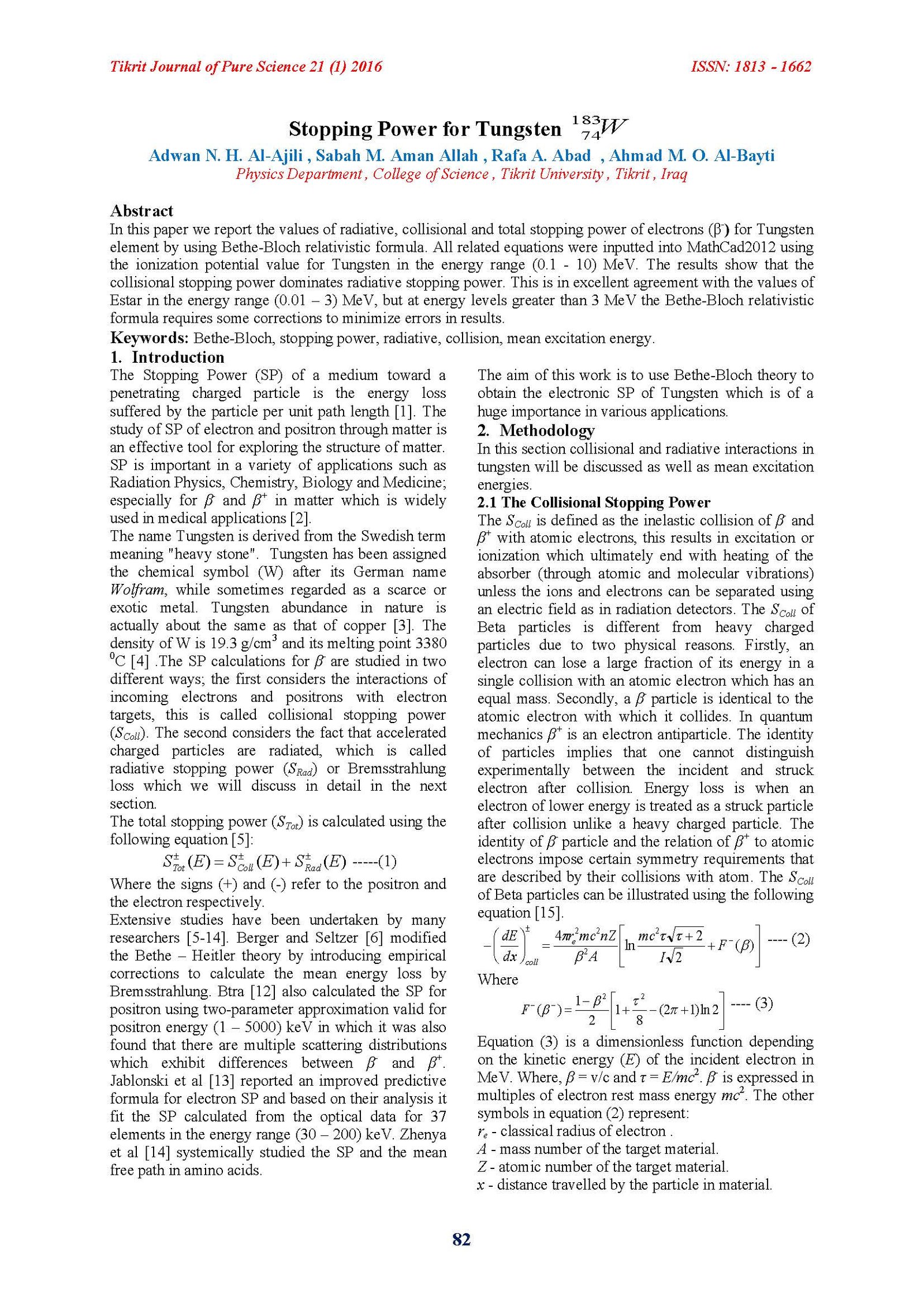Stopping Power for Tungsten
Main Article Content
Abstract
In this paper we report the values of radiative, collisional and total stopping power of electrons (β-) for Tungsten element by using Bethe-Bloch relativistic formula. All related equations were inputted into MathCad2012 using the ionization potential value for Tungsten in the energy range (0.1 - 10) MeV. The results show that the collisional stopping power dominates radiative stopping power. This is in excellent agreement with the values of Estar in the energy range (0.01 – 3) MeV, but at energy levels greater than 3 MeV the Bethe-Bloch relativistic formula requires some corrections to minimize errors in results.
Article Details

This work is licensed under a Creative Commons Attribution 4.0 International License.
Tikrit Journal of Pure Science is licensed under the Creative Commons Attribution 4.0 International License, which allows users to copy, create extracts, abstracts, and new works from the article, alter and revise the article, and make commercial use of the article (including reuse and/or resale of the article by commercial entities), provided the user gives appropriate credit (with a link to the formal publication through the relevant DOI), provides a link to the license, indicates if changes were made, and the licensor is not represented as endorsing the use made of the work. The authors hold the copyright for their published work on the Tikrit J. Pure Sci. website, while Tikrit J. Pure Sci. is responsible for appreciate citation of their work, which is released under CC-BY-4.0, enabling the unrestricted use, distribution, and reproduction of an article in any medium, provided that the original work is properly cited.
References
[1] A. Mozumder, "Fundamentals of Radiation
Chemistry" Ch. 2, pp.12-24 AP Academic Press,
(1999) USA.
[2] Mustafa Cagatay Tufan and Hasan Gumus, "A
study on the calculation of topping power and CSDA
range for incident positrons", journal of nuclear
material 412, pp.308-314 (2011).
[3] Lexicon Universal Encyclopedia W Lexicon
publication Inc New york, (1988), USA.
[4] Halliday, Resnick and Walker, "Fundamentals of
Physics 6th edition" appendix G p.1152 John Wiley &
sons Inc USA (2001).
[5] P. B. Pal, V. P. Varshney and D. K. Gupta,
"Semiempircal stopping power equation for
positrons" Journal of applied physics 60 (1986).
[6] M. J. Berger, S. M. Seltzer, "Stopping powers and
ranges of electrons and positrons" (National Bureau
of Standards Report, NBSIR 82-2550 A, (1982).
[7] H. A. Bethe, Z., Phys. 76, p.293 (1932).
[8] C. Moler, Ann. Phys., 14, p.568 (1932).
[9] H. J. Bhabha, Proc. R. Soc. London Ser A. pp.154
-194 (1936).
[10] F. Fohrlch and B. C. Carlson, Phys. Rev. 93, p.
38 (1953).
[11] H. Bethe and W. Heitler, Proc. R. Soc London
A., 146, p.83 (1934).
[12] R. K. Btra and M. L. Sehgal, Nucl. Phys. A. 156,
p. 314 (1970).
[13] A. Jablonski, S. Tanuma and C. J. Powell,
"modified predicative formula for electron stopping
power "J. Applied physics, p.103 (2006).
[14] Zhenyu Tan, Yueyuan Xia, Mingwmino Zhao
and Xian gdong Liu, "Electron stopping power and
inelastic mean free path in a acids and protein over
energy range 20-20KeV" Rad. Biophysics, p. 450
Vol. 45 (2008).
[15] ICRU "Stopping powers for electrons and
positrons (International Commission on Radiation
Units and Measurements" Bethesda, MD Report, No.
37, 1984.
[16] Mustafa Cagatay Tufan, Onder Kabaday and
Hasan Gumus, "Calculation of the stopping power for
intermediate energy positrons" Chinese Journal of
physics Vol. 44, No. 4, pp. 290-296 China (2006).
[17] Kenth Krane, " Modern Physics 2nd edition" ch.
5, p.145, John Wiley & sons Inc., USA (1996).
